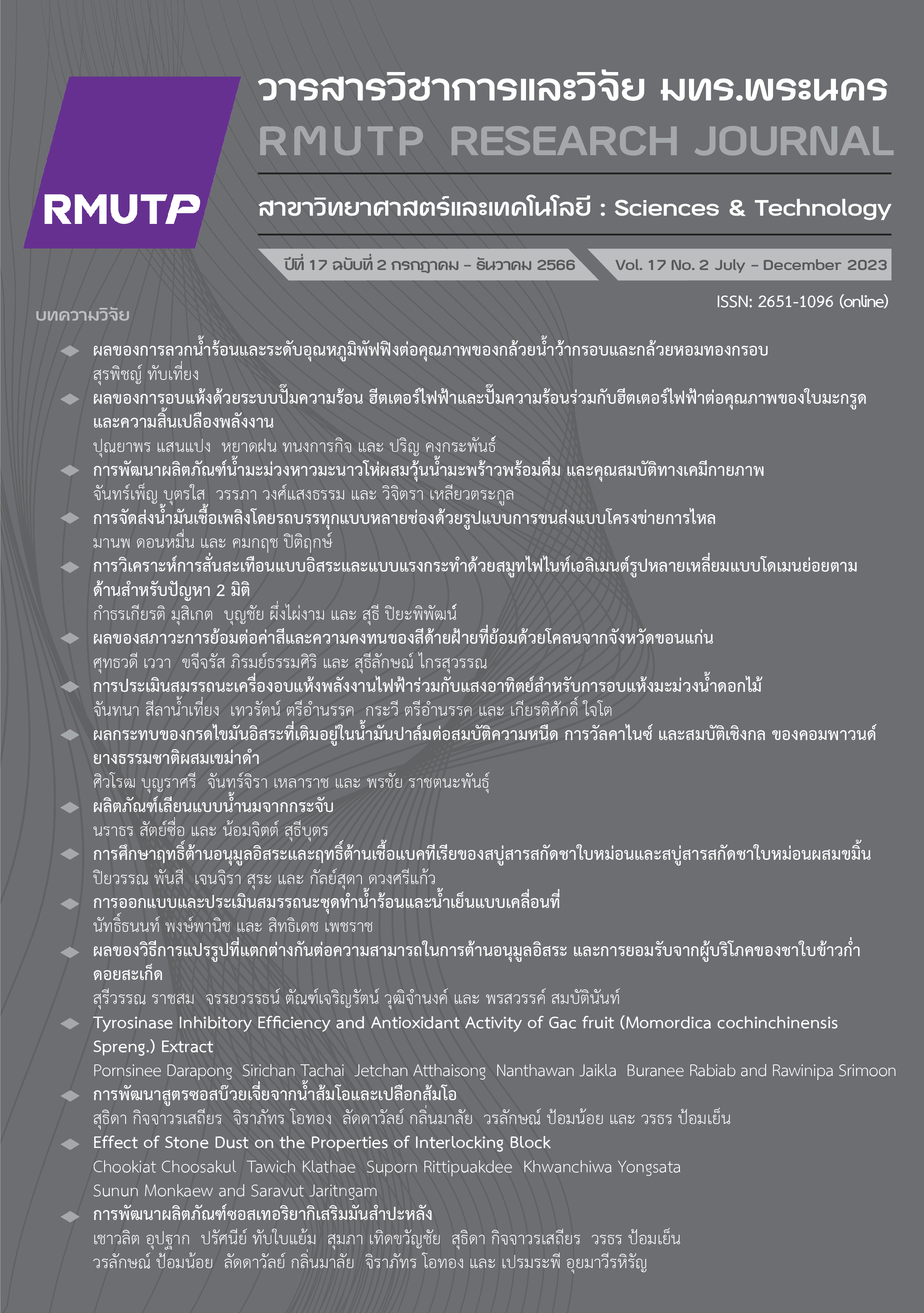Effect of Stone Dust on the Properties of Interlocking Block
Main Article Content
บทคัดย่อ
This research aimed to study the properties of interlocking block mixed with stone dust in the ratio of 0, 10, 20 and 30 by weight of cement. The ratio of cement to lateritic soil was 1: 6 by weight. The optimum moisture content (OMC) was obtained from the Standard Proctor Test. Square interlocking block formwork of round-flowered type with holes, size 12.5 x 10 x 25 centimeters, was formed by a manual compression molding machine. Conduct tests for the compressive strength, density, and water absorption of interlocking block mixed with stone dust in compliance with the Thai community product standard of interlocking block (TCPS 602-2004). The results of the study found that the use of stone dust of cement in the production of interlocking block resulting in increased the water absorption and density, but the compressive strength were decreased. All mixing ratios of interlocking block have the measured properties in accordance with the TCPS 602-2004 for non-load bearing type. The percentage of displacement of stone dust suitable for the production of interlocking block this time is 30% with compressive strength of 4.36 MPa, density of 1,707 kilograms per cubic meter and absorption of water 253 kilograms per cubic meter, respectively, at a curing life of 28 days.
Article Details

อนุญาตภายใต้เงื่อนไข Creative Commons Attribution-NonCommercial-NoDerivatives 4.0 International License.
ลิขสิทธ์ ของมหาวิทยาลัยเทคโนโลยีราชมงคลพระนครเอกสารอ้างอิง
Thailand Institute of Scientific and Technological Research (TISTR). (2020, Jan 9). Interlocking block technology. [Online]. Available: https://technologyblockprasan.com/803/
K, Chaimoon, “Compressive Strength and Behavior of Interlocking Block Masonry under Eccentric Loading” Research and Development Journal, Vol. 21, no. 2, pp. 6-14, 2010.
E. Gartner, “Industrially interesting approaches to “low-CO2” cements,” Cement and Concrete research, vol. 34, no. 9, pp. 1489-1498, 2004.
A. M. Rashad. and S. R. Zeedan, “The effect of activator concentration on the residual strength of alkali-activated fly ash pastes subjected to thermal load,” Construction and Building Materials, vol. 25 no. 7, pp. 3098-3107. 2011.
Breakthrough Energy. (2022, Aug 12). Chement’s patent-pending technology eliminates all CO₂ emissions in cement production. [Online]. Available: https://breakthroughenergy.org/fellows-project/chement/; 2022.
The Office of Industrial Economics. (2021, Jan 29). Industry statistics report. [Online]. Available: https://i.index.oie.go.th/industrialStatisticsReport.aspx.; 2021.
A. Leeanansaksiri, W. Phochan and T. Pongnum, “Development of Interlocking Lightweight Cement Blocks from Sludge Mixed Pozzolan Material,” Engineering Journal of Research and Development, Vol. 31, no. 1, pp. 135-143, 2020.
K. Paopongpaiboon, K. Boonserm, V. Horsakulthai and P. Chindaprasirt, “Development of Interlocking Block Blended with Biomass Ash for Using As a Insulating Material,” Engineering Journal of Research and Development, vol. 30, no. 2, pp. 95-105, 2019.
T. Klathae, “Utilization of crushed oyster shell on interlocking block,” RMUTP research Journal, vol. 11, no.2, pp. 167-177, 2017.
C. Choosakul and K. Yongsata, “High Strength Concrete Using Decomposed-Stone Dust,” in Proceeding of the Annual Concrete Conference 12, Thailand, 2018, pp. MAT01-MAT06.
Standard specification for coal fly ash and raw or calcined natural pozzolan for use in concrete, ASTM C 618, 2003.
I. B. Muhit, M. T. Raihan and MD. Nuruzzaman, “Determination of mortar strength using stone dust as a partially replaced material for cement and sand,” Advance in Concrete Construction, vol. 2, no. 4, pp. 249-259, 2014.
Department of Industrial Works. (2021, Feb 3). Factory information. [Online]. Available: https://userdb.diw.go.th/results1.asp.
Standard specification for Type 1 Portland cement, TIS 15, 2004.
S. Assiamah and H. Danso, “Effects of Sand on The Properties of Cement-Laterite Interlocking Blocks,” in Proceeding of the West Africa Built Environment Research (WABER) Conference, Ghana, 2021, pp. 569-578.
P. Khamput, “Development of Light-weight Interlocking Block Product form EVA Plastic Wastes,” Thai Environmental Engineering Journal, vol. 30, no. 3, pp. 57-64, 2016.
N. Intaboot, “Innovation of Interlocking Block Mixing with Biomass for Sound Absorption and Thermal Conductivity in Thailand,” Journal of Advanced Concrete Technology, vol. 18, no. 8, pp. 473-480, 2020.
Standard Test Methods for Laboratory Compaction Characteristics of Soil Using Standard Effort, ASTM D 698, 2006.
Standard Test Methods for Specific Gravity of Soil Solids by Water Pycnometer, ASTM D 854, 2006.
Standard Practice for Classification of Soils for Engineering Purposes (Unified Soil Classification System), ASTM D 2487, 2017.
Standard Test Methods for Particle -Size Analysis of Soils, ASTM D 422, 2007.
Standard Test Methods for Liquid Limit, Plastic Limit, and Plasticity Index of Soils, ASTM D 4318, 2005.
Thai community product standard of interlocking block, TCPS 602, 2004.
Hollow Loadbearing Concrete Masonry Units, TIS 57, 2017.
Standard methods of sampling and testing brick and structural clay tile, ASTM C67, 2007.
M. Gidigasu, “Laterite Soil Engineering: Pedogenesis and Engineering Principles,” 2nd ed., Amsterdam: Elsevier, 2012.
Standard Specification for Classification of Soils and Soil–Aggregate Mixtures for Highway Construction Purposes, AASHTO M145-91, 2012.
Standard Practice for Classification of Soils and Soil-Aggregate Mixtures for Highway Construction Purposes, ASTM D 3282, 2015.
A. Boksuwan and P. Khamput, “Interlocking Block Product for Community Enterprises from Anhydrite Rock Fragments,” in Proceedings of 3rd National RMUTR Conference. Thailand, 2018, pp. 19-26.
N. Janpetch and W. Kokkamhaeng, “The Test of The Compressive Strength of an Interlocking Block of Thailand,” RMUTSB ACADEMIC JOURNAL, vol. 4, no. 2, pp. 196-206, 2016.
P. Chindaprasirt and C. Jaturapitakkul, “Cement pozzolan and concrete,” 7th ed., Bangkok: Thailand Concrete Association, 2008.
P.O. Awoyera and I.I. Akinwumi, “Compressive strength development for cement, lime and termite-hill stabilized lateritic bricks,” The International Journal of Engineering and Science, vol. 3, no. 2, pp. 37-43, 2014.


